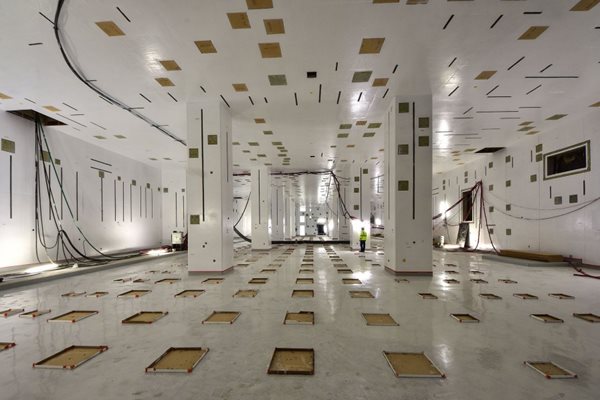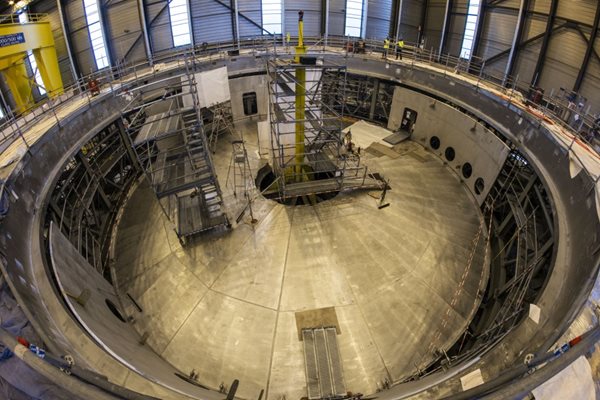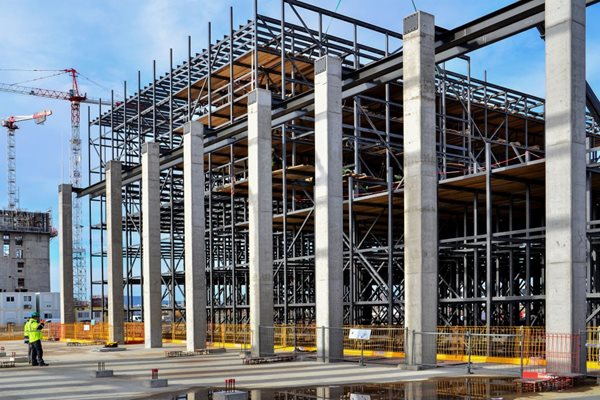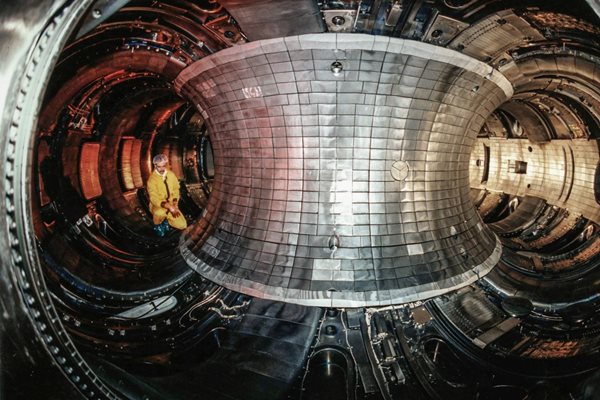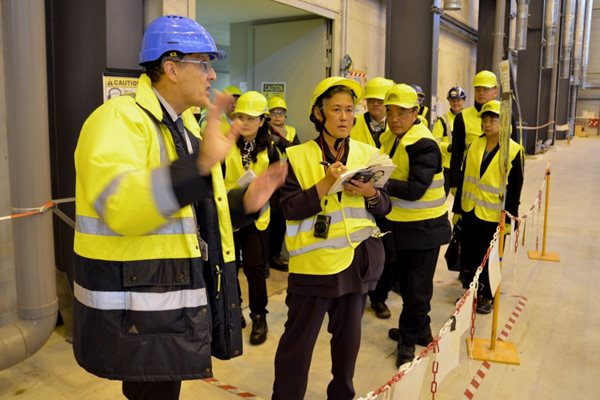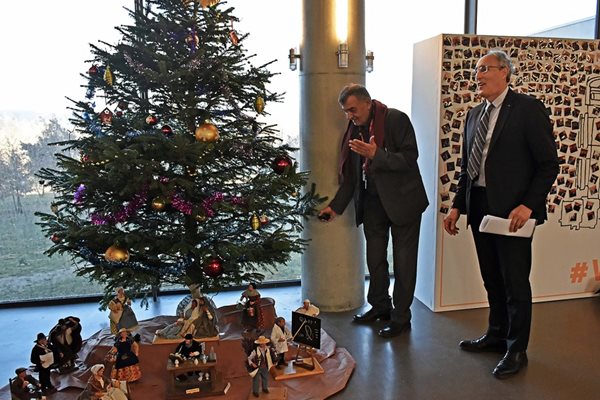
you're currently reading the news digest published from 10 Dec 2018 to 17 Dec 2018
featured7
press12
featured
From the crane | When dusk falls
There is a magic moment at dusk when the ITER site lights up and the sky still retains some of the light of day. Details that were washed out by the intense daylight or buried in the deep shade jump to the eye as warm yellowish sodium lights, white halogen and the occasional blue-green glow of a welding torch combine to create an unreal atmosphere. Although familiar by now, this view has no equivalent in the world. This is a giant tokamak being constructed—a unique venture with unique features that the camera loves to capture. The walk-around continues in the gallery below.
Main buildings | Under, over and beside the Tokamak
In the immediate vicinity of the machine—in the deep vaults of the Tokamak Complex or under the high rafters of the Assembly Building—construction teams are preparing for 2019 assembly-related activities. Whether it is receiving and handling the first major components or beginning to install the first structural supports for system components in the concrete buildings, the coming year will mark the transition on site between a heavy focus on construction, to the management of construction and machine and plant system assembly activities in parallel. Under the financial and oversight responsibility of the European Domestic Agency civil construction works on site are progressing, and are soon to pass the 70 percent completion mark. As buildings are completed, the ITER Organization has the overall responsibility for the integration and assembly of components delivered to the ITER site by the seven Domestic Agencies. The actual work of the assembly phase will be carried out primarily by ITER Organization contractors (or, for some plant assembly works, by Domestic Agency contractors). Work will be tendered out in nine main contracts. In the build-up to full-scale assembly, which begins with overhead crane access to the Tokamak Building in March 2020, components are arriving on site with increasing frequency. In 2019 a number of major arrivals are planned, including the first toroidal field coil, the first vacuum vessel sector, assembly tooling, and the first thermal shield segments. Installation activities will start in the lower levels of the Tokamak Complex while in the Assembly Hall, the first specialized assembly tools will be moving into action. See more detail in the gallery below.
Cryostat | Home stretch for base and lower cylinder
Just over two years after the first welding activities were initiated in the Cryostat Workshop at ITER, Indian Domestic Agency contractors are executing the final assembly tasks on the two lower sections of the cryostat—the base and the lower cylinder. Site acceptance tests are planned in March/April. On large steel frames at either end of the Cryostat Workshop ITER's largest component—and the world's largest stainless steel high-vacuum pressure chamber—is taking shape. The 29 x 29 metre cryostat has two important functions in the ITER machine: it provides a vacuum environment to critical "cold" components (the magnets operating at 4.5 K and thermal shield operating at 80 K); and it has a structural role in supporting the mass of the Tokamak and transferring horizontal and rotational forces to the radial walls. The assembly of the cryostat has been underway since September 2016, when teams of welding specialists began assembling the pie-slice-shaped segments of tier one of the base. Work began in 2017 on the lower cylinder and today, the fabrication of both lower sections has advanced to the final activity stage under Indian contractor Larsen & Toubro (manufacturing design, fabrication and assembly) and sub-contractor MAN Energy Solutions (welding). The last seam welds are underway now on the lower cylinder, while the three parts of the base—lower sandwich, upper pedestal, and vertical shells—have been aligned for final welding and assembly. See more detail in the gallery below.
Auxiliary buildings | Support for the machine
A tokamak would be a lifeless machine if it was not supported by a significant industrial infrastructure. On the ITER platform close to 40 buildings host the equipment and systems that make burning plasma experiments possible. A tokamak needs to be fed electrical power in both AC and DC form; it requires powerful heating systems to bring the plasma to the required temperature; the machine's superconducting magnet system demands a constant circulation of cooling fluids; the heat generated on the plasma-facing components must be evacuated by a large water cooling system, complete with kilometres of piping, basins and cooling towers. See the gallery below to see some of the under-sung areas of the ITER worksite that host critical plant systems.
US National Academies | "US should remain in ITER"
The US National Academies of Sciences, Engineering, and Medicine has completed a multiyear study of the overall status of magnetic confinement fusion research in the United States. Its recommendation? Continued US participation in the ITER Project and an unambiguous increase in funding for the domestic fusion program leading to the construction of a compact pilot plant. The Final Report of the Committee on a Strategic Plan for Burning Plasma Research was the latest in a number of steps undertaken by policymakers in the United States to evaluate the state of domestic fusion research—including current and planned participation in international programs—and to develop a strategic plan for the future. In 2016, after a detailed evaluation of the ITER Project, the US Department of Energy issued a report to Congress recommending continued US participation in 2017 and 2018 as 'in the best interest of the nation.' The report also suggested a re-evaluation of US participation based on project progress prior to the Fiscal Year 2019 budget submittal. The committee formed to carry out this re-evaluation—the Committee on A Strategic Plan for U.S. Burning Plasma Research—delivered an interim report one year ago on the importance of burning plasma research to the development of fusion energy as well as to plasma science and other science and engineering disciplines. In it, ITER was highlighted as 'the only existing project to create a burning plasma at the scale of a power plant.' The final report issued this month makes two recommendations: First, the United States should remain an ITER partner as the most cost-effective way to gain experience with a burning plasma at the scale of a power plant. Second, the United States should start a national program of accompanying research and technology leading to the construction of a compact pilot plant that produces electricity from fusion at the lowest possible capital cost. 'ITER is a burning plasma experiment and the critical next step in the development of fusion energy. It is a large and ambitious project that integrates multiple advanced technologies and combines the scientific and engineering expertise, industrial capacity, and financial resources of many nations. As a partner, the United States receives full benefit from the technology developed for ITER while providing only a fraction of the financial resources. Methods to control the plasma and extract the electricity-producing heat will be tested and developed. U.S. industry is building major systems for ITER and thereby gaining expertise in fusion engineering science and building industrial capabilities." [Executive Summary] See the press release for more information or to download the full report.
Visit | A Princess Royal with a passion for science
Her Royal Highness Maha Chakri Sirindhorn of Thailand is a princess with a passion for science, development and education. The daughter of King Bhumibol the Great, who reigned for more than 70 years over the Southeast Asian nation—and the younger sister of the present monarch, King Maha Vajiralongkorn, who acceded the throne in 2017—the Princess Royal is no newcomer to fusion: along with leaders of Thailand's science and technology agencies she has visited fusion installations at Lawrence Livermore National Laboratory in the US and the EAST Tokamak in China, toured the Jülich research centre in Germany, and presided at the handing over of the HT-6M tokamak that China recently donated to the Thailand Institute of Nuclear Technology. The Princess Royal clearly supports fusion as an option for a major contribution to the future world energy supply. Accompanied by a large party of scientists, diplomats and high-level officials, she recently honoured ITER with a half-day visit. Her interest in fusion and in fusion's flagship ITER was obvious: throughout her visit to the Cryostat Workshop (photo above), the Assembly Hall, the cryoplant, the Tokamak Building and the virtual reality room, the Princess Royal carefully wrote the highlights of Director-General Bigot's explanations on a notepad, took pictures with her small camera, and inquired about the technical details of fusion and societal perspectives. She told Bernard Bigot that her father, more than 30 years ago, had stressed to her that the world energy future would need nuclear power and already mentioned fusion energy as a promising option. The visit of the Princess Royal and her party was also the occasion to witness the signature of a Cooperation Agreement between the ITER Organization and the Thailand Institute of Nuclear Technology (TINT), represented by its Executive Director Pornthep Nisamaneephong (photo above). The Agreement aims to promote the public understanding and acceptance of fusion energy. It will provide courses and lectures to young students and scientists in Thailand and facilitate visits to ITER by TINT scientists, young experts and students.
Image of the week | Ringing in the festive season
A beautiful Christmas tree set in the middle of a Provençal nativity scene in the ITER lobby has brought the festive season to ITER. The tree is a gift of the mayor of Saint-Paul-Lez-Durance, Roger Pizot, who turned the switch in the traditional tree lighting ceremony on Friday last week, in the presence of Director-General Bernard Bigot and ITER staff. Expressing his appreciation and thanks, Bigot said that 'the tree symbolizes Mr. Pizot's generosity towards ITER and his continuous and strong support for ITER in the community.' A keen observer could spot the ITER scientists among the 'santons,' the little saints, traditional figurines that make up the nativity scene. Clad in a white cloak, the scientist points at a miniature blackboard and reminds us of the scientific goal of ITER—to produce 500 MW of fusion power from 50 MW of injected heating power (Q≥10).

